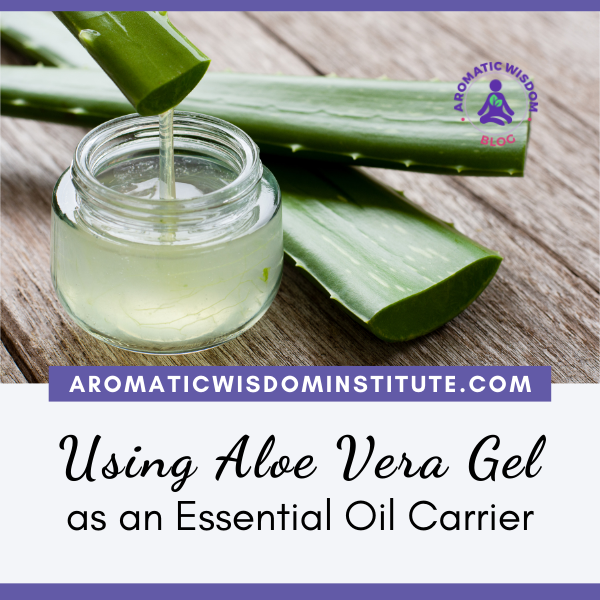🎧 Prefer to listen? AromaticWisdomPodcast.com/53
📖 Prefer to read? The Blog Post is Below! 👇
Every aromatherapist needs a wide selection of carriers in which to mix their essential oils (read why in my Blending Dilutions Guidelines blog post).
No single carrier will be right for every aromatherapy application, so, logically, you’ll have a choice of different bases in your aromatherapy blending kit. I’ve used many carriers over my 33 years of making essential oil blends, like luxurious vegetable and nut oils, rich creams, light lotions, and heavy body butters. One of my favorite essential oil carriers, especially in the summer, is the versatile Aloe Vera gel.
When purchasing your Aloe vera gel, it’s important that you get the real thing. Never buy the aloe vera gel sold in big box stores or local drug stores as it is probably full of synthetic chemicals and color dyes. To ensure you get the real plant extract, and hence the healing benefits, buy your Aloe vera gel from a company that sells natural wellness or aromatherapy products. If you already buy essential oils from a great company, then I’m guessing you can also trust their aloe vera gel.
In the box below you can see the list of [nasty] ingredients from a bottle of “Aloe Vera gel” I found in a popular local drugstore.
How is Natural Aloe Vera Gel Made?
High-quality commercially-sold Aloe Vera gel is made by pulverizing the translucent inner “meat” of organically grown Aloe Vera plants. This plant material is then filtered to produce a clear aloe gel that may contain very tiny bits of pulp. The consistency is thin enough to render it pourable which I love because it can be added to a spray bottle for sunburns or making your own hand sanitizer. The odor should be fresh and clean and the shelf life is about 2 years if kept cool. I keep mine in the fridge. When it gets old and past its shelf life or left in a warm environment, it begins to oxidize and takes on an awful aroma somewhat like sour milk. I used to keep an old bottle for students to do a comparison sniff test in which they would smell fresh aloe versus old aloe.
Aloe Vera Gel is made by scraping the inner “fillet” from
Aloe Vera plants. Keep it in the refrigerator.
Aloe Vera Gel Uses
Below are 5 ways you can use organic Aloe Vera gel as an essential oil carrier to bring topical relief PLUS some easy recipes:
1. Topical Burns
This is the carrier of choice when addressing a burn; any kind of burn. There are a lot of ways we can burn our skin: sunburn, windburn, touching hot metal such as a motorcycle muffler, stove or iron, when splashed with hot oil while frying. Even an electrical burn. The Aloe Vera plant alone helps heal the skin from a burn and when you add Lavender essential oil the blend is incredibly effective for cooling and healing the area. For adults, use 10-12 drops of Lavender for every ounce of the Aloe Vera gel for a 2% dilution. For children under 6, go with 5-6 drops for a 1% dilution. Read this post for more Essential Oil Blending Guidelines and Dilutions.
2. Topical Fungus
Aloe vera gel is my go-to carrier for topical fungal conditions. Fungus issues will worsen when covered, so avoid heavy carriers that occlude, like oils and butters. Aloe vera gel is perfect for topical fungal conditions because it is light and doesn’t offer a heavy, thick covering, but is safe enough to protect the skin. For fungal conditions of the skin like ringworm, athlete’s foot, or the very common Tinea Versicolor, try my favorite recipe below. It has always shown great results in getting rid of fungus on both children and adults.
Ingredients:
- 10 drops of Lemongrass essential oil (in the Aldehyde Chemical family which is great for addressing all fungal conditions)
- 5 drops of Palmarosa essential oil (in the Monoterpenol Chemical Family which is great for nourishing the skin). The Palmarosa helps to protect the skin from the irritating effects of the Lemongrass, and it also has anti-fungal properties.
- Pour the Aloe Vera gel into a 1 oz glass spray bottle
- Spray the affected area 2-3 times a day. Let it dry before putting on clothes.
3. Relief from Itching
Aloe vera gel will offer relief from itchy conditions like poison ivy or mosquito bites and the cooling aspect feels delightful on hot itchy skin. If the itch is caused by something other than just being overheated, try adding 10 drops of Tea Tree and 5 drops of Peppermint to help calm the maddening itch. For Poison Ivy, Poison Oak, or Hives, I suggest this awesome recipe for a DIY Homemade Calamine Lotion.
4. Relief from Eczema
Aloe vera gel will help minimize the inflammation and puffiness from eczema.
Quick and Easy Recipe: Aloe Vera Gel + Essential Oils for Eczema: In 1 oz (30 ml) of Aloe Vera gel, simply add 5 drops each of the following essential oils: German Chamomile or Blue Tansy, Lavender (L. angustifolia) and Helichrysum (H. italicum).
5. As a Hand Cleanser
Quick and Easy Recipe: Simply pour 1 fl oz (30 ml) of Aloe Vera Gel into a small spray bottle and add 20 drops of your favorite essential oils for an instant, all-natural hand cleaner. My favorite essential oils to use for this purpose are Laurel Leaf, Ravintsara, Lemon, Orange, and Clove (not more than 2 drops). Your hands will smell divine! After you spray it into your palms, it may feel sticky for a minute until it dries.
Where to Buy Organic Aloe Vera Gel?
This is what have used and really like: Seven Minerals Organic Aloe Vera Gel
Originally published in 2015. Updated June 13, 2024. This blog post may contain affiliate links, meaning I may receive a small commission if you purchase using them. The commission is paid by the retailer at no extra cost to you.







Hi I have found that this post to of great value all those uses of aloe vera was just awesome and I really never knew that it can be used for eczema and burns, thanks a lot for all this info. I would also love to share some info on aloe vera.
We rescued a tiny Chihuahua from the streets. She had awful fly bites all over her ears. Pure aloe vera gel healed them in no time. Love this great stuff!
That is SO great to hear Stella’s Mom! (Is Stella the name of your puppy?) Chihuahua’s are such small mammals that we really have to watch what we put on them with both vet-prescribed meds as well as herbal remedies. I am delighted to hear that you had good luck with aloe ver gel with your baby! I will be sure to remember that with my own animals in future. Thank you for sharing! Liz
So when you combine essential oils with real Aloe Vera Gel, like say for hand sanitizer, do you need to keep your newly made hand sanitizer bottle in the refrigerator too?
Hi Valerie, well, if not in the fridge, then keep it in a cool spot. If you can’t keep it cool (like in your purse) then only make a very small batch and use it up, and keep the rest in the fridge. It really doesn’t have a long shelf life and you’ll know when it goes off because it will start to smell sour. When that happens, dump it and buy new. Best to just buy in small quantities more frequently. Thanks for asking, that was a great question Valerie! Liz
Hi Liz,
I’m a big fan of DIY and I have easy access to the actual plant. How do you feel about making our own aloe vera gel at home? Thank you _/\_
I think making your own aloe vera gel at home is a great idea, but you’d have to use it up fast as it will have a very short shelf life. Here is a post I found in Ehow that share how to make it at home. https://www.wikihow.com/Make-Aloe-Vera-Gel Let me know if you do make it at home and if you like the product.
Thank you for sharing your thoughts Liz. I made it for the first time last week and it only lasted 4 days even though I added vitamin E to it (off the top of my head!!!). I’m going to follow the wikihow tip on adding vitamin C instead and let you know how it goes. I used it for seborrheic dermatitis and it seemed to be working well. I also used it as a facial and body moisturizer and my skin was loving it. I grew up seeing my parents use the actual Aloe Vera plant for treating all sorts of skin conditions but I don’t find using the plant very practical. The gel is easier to use and quite simple to make. Once I manage to make it so that it lasts at least a week, I’ll begin adding oils 🙂
https://any suggestions on where to purchase the powdered vitamin c?
Betsy, here is a link to Powdered Vitamin C. Hopefully this is what you’re looking for! 🙂 Liz
Star West or Frontier sells it in bulk bags, I put it on my dogs food.
This is great information. What would you recommend for burnt/scared underarms from a purchased essential oil deodorant? I would like to use aloe Vera/vitamin E as the carrier oil. Also how would I know how much one ounce is when making it myself? Thank you
Hi Kai, Oh dear, I’m so sorry you have scarred underarm tissue from a purchased essential oil deodorant. I’m curious. What were the essential oils in that product? If you are looking to soothe the burned tissue, then yes, organic Aloe Vera gel is best. Make sure it is fresh.
As for how to measure out one ounce, that’s a great question! First of all, you should be aware that ounces can be a measurement of either mass or weight. When measuring ounces by weight, you can simply use a scale. On the other hand, fluid ounces are a measurement of volume, so they are measured with a measuring cup with lines or a graduated cylinder. You can find both easily on Amazon. Since Aloe vera gel would be measured as a fluid ounce, you can simply use a measuring cup or graduated cylinder to measure out your Aloe vera gel. By the way, fluid ounces are part of the American Standard system, whereas the Metric system uses milliliters and liters. Therefore 1 fluid ounce = 30 ml (milliliters).
Hope this helps! Liz
When mixing essential oils with aloe Vera gel do you need to melt it first?
Hi Diane, Organic Aloe Vera gel is liquid, so there is nothing to melt! 🙂 Liz
The post very informative. Keep posting.
If I mix aloe vera gel with coconut oil will I need to refrigerate it?
Yes, you sure will. Coconut oil won’t act as a preservative.
I want to be able to mix essential oils with aloe vera for resale what preservatives do I need so it doesn’t go bad in a few days?
What essential oil would smell best with aloe vera gel?
Hello, I’m making “padsicles” to use after I have my baby. I would like to use lavender and dilute it with aloe Vera. Would this be safe to do? I don’t want to burn myself. Also does lavender dilute in witch hazel or will it float on top and still potentially cause burns or irritation? Thank you.
Hi Leah, Yes, that would absolutely be safe, and what a wonderful idea! Lavender will probaby separate a bit in witch hazel, floating on the top. I would add Organic Aloe Vera gel to the witch hazel. You can find it here: https://pompeiiorganics.com/aloe-vera-gel/ Best of Luck Leah! Liz
Hi Leah, Yes, that would absolutely be safe, and what a wonderful idea! Lavender will probably separate a bit in witch hazel, floating on the top. To avoid this, add a bit of organic Aloe Vera gel to the witch hazel. You can find it here: https://pompeiiorganics.com/aloe-vera-gel/ Best of Luck Leah! Liz
Can I mix carrier oils like argan oil into the aloe Vera gel? Also can I mix small quantities of about 3 carrier oils and 3 essential oils into a bottle for a ton of benefits? Then this can be a lightweight moisturiser that is an effective emulsifier. Thanks for much for the great article and idea.
Hi there. I suffer badly from prickly heat when I go o holiday, which is so itchy. would a combination of lavender oil and Eucalyptus oil, mixed with pure Aloe Vera help me ?
Hi Sue! Actually, if you use just pure, organic Aloe Vera Gel that should be enough to soothe your skin, or a nice cool Lavender hydrosol. The skin is already hot, irritated and compromised so I wouldn’t use essential oils at all. Thanks for asking and I hope you feel better soon!
I have found that when I add aloe gel to a carrier oil with essential oil it turns creamy which I love! I have often wondered if mixing compromises the benefits of each of the oils. Any thoughts?
what is the dryest/litest carrier oil, i want to make a mix to use on my dogs and do not want them looking oily.
The lightest essential oil carrier would be organic aloe vera gel. The only thing lighter, and it really isn’t a true carrier, would be hydrosol, but then you’d have to add some aloe vera gel to disperse the essential oils anyway. They definitely won’t look oils with aloe very gel! I use it on my cats. It’s sticky for a minute until it dries then the fur will be very soft!
Hello Can 100% aloe vera gel be used As a carrier oil for all essential oil’s? The reason I ask is that I don’t like any oily stuff on my skin Such as any carrier oils like baby oil or mineral oil or Coco oil,but I love aloe vera. Also can Aloe be used as a carrier oil with CBD. I have back issues and I would like to try the CBD topical but I would like to mix it with aloe vera instead of any oily products. Again I don’t like oily products on my skin. Thank you in advance for your answer
Yes, it sure can! Just know that it will be lighter than oil and will absorb very quickly so do be mindful of the “hot” oil like oregano and thyme. Maybe go a bit lighter with those essential oils.
I plan on making a DMSO pain salve with organic aloe gel, magnesium and an essential oil or two. If I add a couple of caps of Vit E, will it be a worthwhile preservative or is there something else that would work better? Also, will the essential oils blend well with the aloe or float up.
Hi Lee! I’m not familiar with the initials DMSO, but if you want to make a pain salve with organic aloe vera gel, magnesium (powder?) and an essential oil adding a couple of caps of Vitamin E may help slightly to preserve it, but in general the gel should never get heated for very long as it will go rancid. I had some that spoiled and it smelled like sour milk, so that would be an indicator. You might even want to add some vodka or Everclear alcohol as a preservative. Note, that that will also thin the blend. I still advise keeping it cool. If you need to make a large batch, then just keep out an ounce (30 ml) for use if the temperature is a concern.
As for your second question, the essential oils will blend beautifully in the Aloe Vera gel! No floating to the top. That happens with water because they simply do not disperse in water. Hope that helps, Lee! Liz
Can I add Rose water to Aloe Vera gel. what will the shelf life of this keeping in refrigerator. Thanks
Hi Ahemd, yes, you can add rosewater to aloe vera gel, but without knowing more about the rosewater product I can’t give you a very precise shelf life. I would go by the shelf life of the aloe vera gel. In general, one year is a safe estimate. Great question! Liz
Hi Liz, thank you for all your knowledge you share. We live in South Africa on the South Cape coast where Aloe Ferox grown in abundance and is used in many traditional healing products. Can you advise us pls on what you would use to preserve it the most natural way.
Kind regards
Ant
Hello Ant! Adding preservatives isn’t in my wheelhouse, but I do know that a lot of companies use Rosemary extract as a natural preservative. I know you can freeze your aloe vera as well, though that’s not very helpful for keeping it fresh when it’s NOT frozen! This article on using preservatives may help. https://www.fromnaturewithlove.com/library/preservatives.asp Let me know what works for you…and visiting beautiful South Africa is on my bucket list! Liz
Hi Liz, what can I use as a natural preservative for an emulsion of coconut oil and aloe Vera gel? Is another preservative required other than that’s used in the gel itself?
Preservatives really aren’t in my wheelhouse I’m afraid as I tend to make things in small batches, use them up then make a fresh batch. Perhaps a vitamin E capsule? I did find this article which you may find helpful https://www.schoolofnaturalskincare.com/natural-preservatives-for-cosmetics/ Good Luck! Liz
Hello Liz, wonderful post! I wanted to make a salve for my dogs skin. He is yeasty so gets smelly scabby and itchy and has hair loss if left. In the past Neem oil has been his saviour, it healed his skin fast and made the fur grow back – but the smell he hates! So I have been buying a salve that works really well too the ingredients are Aloe Gel, Tea Tree, Neem and Palmarosa. Please, are you able to advise me how many dro
ps of each oil I could use per 100ml of Aloe Gel to make up an effective salve, as I have all the ingredients at home. Thank you!
Hi Alison! Poor puppy! Have you seen a vet to determine why he might be scabby and yeasty? The first thing I always use with dogs and cats is hydrosol. Lots of hydrosol. It is safe and very effective for all kinds of skin issues that our fur babies suffer from. I’d start with Lavender hydrosol frequently dabbed onto his skin – several times a day. You might also add some Peppermint hydrosol to soothe the itching and the aroma. If that doesn’t offer him relief, and Neem has worked (I agree, it smells super funky),why not simply add Palmarosa to the Neem? To answer your question I would use 6 drops of essential oil for every ounce of carrier. I normally don’t recommend using essential oils with dogs, but at a 1% dilution in salve he should be fine. Let me know what works!! Liz. PS. You can learn more about Hydrosols in my free training: https://aromaticwisdominstitute.teachable.com/p/what-are-hydrosols